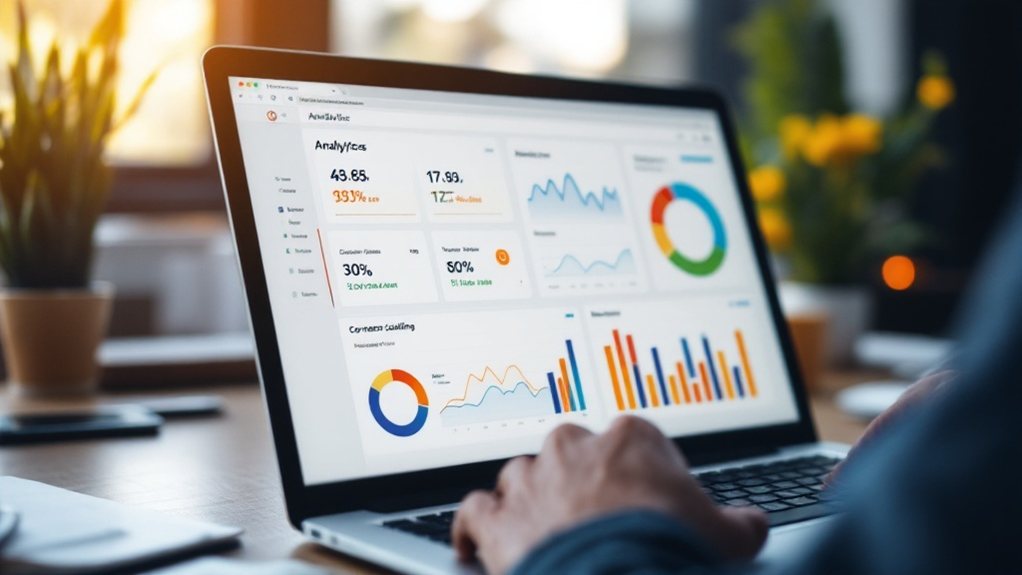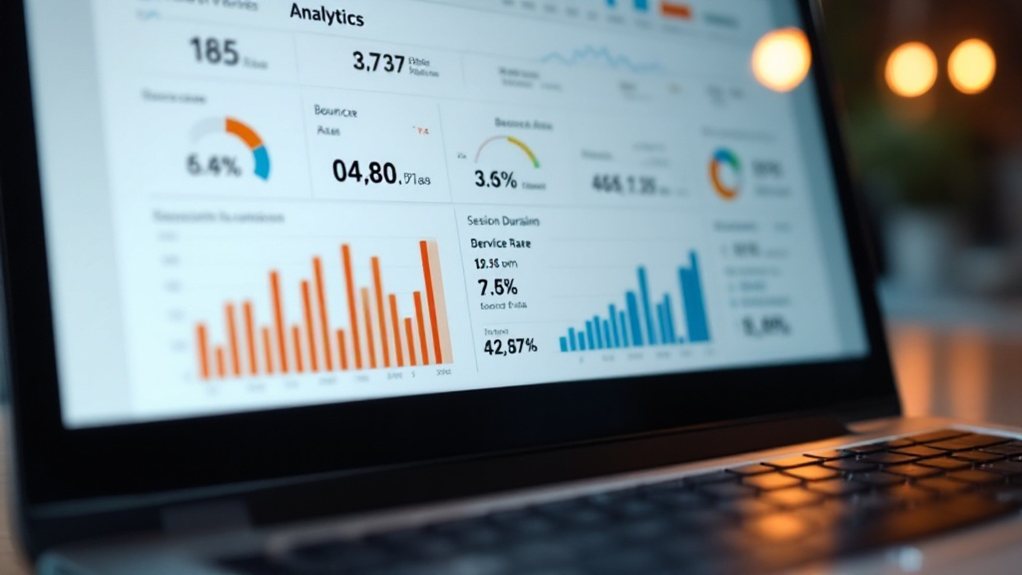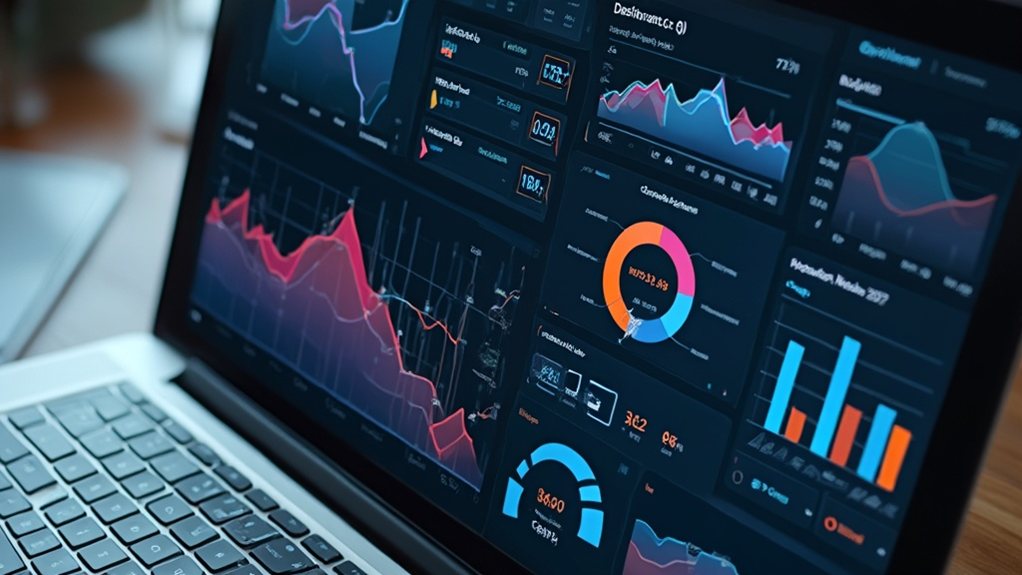To measure the performance of your service area pages, track key metrics like page views, unique visitors, bounce rate, session duration, conversion rates, and user interactions. Analyze engagement, technical performance, and local SEO factors to identify optimization opportunities that enhance the user experience and drive more qualified leads. Leveraging advanced analytics tools can provide a holistic view of your page's effectiveness – and there's even more you can do to boost your online visibility.
Tracking Page Views and User Engagement

Tracking page views and user engagement is crucial for understanding how your service area pages are performing. Monitor the number of visits to each page to gauge interest in specific services and locations. Track unique user counts to comprehend the reach and uniqueness of your content. Measure returning visitors to assess the effectiveness of your content in engaging repeat traffic. Analyze entry and exit pages to optimize the initial user experience and identify where users lose interest. Assess time on page, pages per session, social shares, and conversion rates to evaluate content engagement, utility, resonance, and business impact. Leverage analytics tools to gain these valuable insights and make data-driven decisions.
Analyzing Bounce Rate and Session Duration

Your website's bounce rate and session duration are key indicators of user engagement. Analyze these metrics to understand how visitors interact with your service area pages. By optimizing content relevance and enhancing the user experience, you can improve these performance benchmarks and increase customer conversions. Service pages tend to have a lower bounce rate of 20 to 30% due to users' specific intent, which is a crucial consideration when evaluating your service area pages.
Understand Bounce Behavior
Analyzing your site's bounce rate and session duration can provide valuable insights into user engagement and content relevance. Bounce rate differs depending on the industry and acquisition channels, which can range from 10-30% for service pages. Factors like device type and traffic source can influence bounce rates, so segment your data accordingly. Identify pages with high bounce rates and investigate the causes, such as slow loading times or non-engaging content. Session replay tools and zoning analysis can help uncover user behavior patterns on these pages. Leverage this data to optimize your service area content and design, improving user experience and reducing bounce rates.
Optimize Session Length
Regularly monitoring session length can shed light on user engagement and areas ripe for optimization. Longer session times indicate valuable content, boosting conversions and brand impressions. Session length directly impacts user engagement. Intuitive navigation and fast-loading pages keep visitors engaged. Tailoring content using AI can also increase session length by providing relevant experiences. To enhance session duration, focus on developing high-quality, relevant content and ensuring a seamless mobile experience. Engaging content, interactive elements, and valuable insights can keep visitors interested and on the site longer. Effective CTAs and interactive elements can engage users further. Additionally, featuring customer reviews and testimonials can build trust and encourage longer site interactions. Tracking exit pages and optimizing them can decrease bounce rates and increase session length, positively impacting your SEO.
Assess Content Engagement
Assessing content engagement is crucial for understanding how users interact with your website. Time spent on page, bounce rate, and session duration provide valuable insights. Higher engagement metrics like longer session durations suggest effective content, while lower metrics may require adjustments. Bounce rate – the percentage of single-page visits – can indicate information delivery quality or poor engagement. Aim for lower bounce rates by incorporating internal links and enhancing the user experience. Session duration, the total time across all pages, is a key engagement indicator, with 2-3 minutes being an industry standard for engaging content. Analyze this metric alongside bounce rate and pages per session to optimize your content for maximum user engagement. Analyzing these metrics can also provide insights into the content's relevance to your target audience.
Monitoring Conversion Rates and Lead Generation

Monitoring your website's conversion rates and lead generation performance is crucial for understanding the effectiveness of your marketing efforts. Aim for an industry-leading conversion rate of 4.6% for professional services or the 5.89% average across all industries. Organic search and paid ads have different conversion rates, with organic at 2.7% and paid at 3.2%. Focus on high-converting landing pages for lead gen, which average 9-12%, versus ecommerce pages at 2-5%. Enhance conversion rates through A/B testing and user-generated content. Track lead quality, visitor-to-lead rate, and lead nurturing metrics to optimize your lead generation strategy and improve return on investment. Service area pages are critical for ranking in local search, so monitoring their performance is equally important.
Evaluating Page Load Times and Technical Performance
As a website owner, you can't afford to overlook the importance of your service area pages' load times and technical performance. Page speed is critical for SEO, affecting user experience and search rankings. Leverage tools like Google's PageSpeed Insights to measure key metrics, including Time to First Byte, First Contentful Paint, and Largest Contentful Paint. Slow pages lead to higher bounce rates and lower engagement, so optimize by:
- Reducing image sizes
- Minimizing JavaScript
- Enhancing server response times
Google has indicated that site speed is one of the signals used by its algorithm to rank pages. Additionally, ensure your XML sitemap is complete, URLs are clear, and pages are mobile-optimized. Implement LocalBusiness schema markup and strategically link between service areas. Regular audits and data analysis will uncover optimization opportunities to improve your service area pages' technical performance.
Measuring Key User Interactions and Behavior
Analyzing user engagement is crucial for improving your service area pages. Look at metrics like engagement rate, pages per session, and session duration to gauge how well your content resonates. Understanding interactions per visit and time on page can also reveal opportunities to enhance the user experience. Tracking these user engagement metrics can help you identify areas for improvement and optimize your service area pages for better performance.
Engagement Metrics Analysis
Engagement metrics are critical for gauging users' interest and interaction with your content, which is vital for both search engine optimization (SEO) and enhancing the overall user experience. Google Analytics 4 (GA4) offers powerful tools like engagement rate and average engagement time to help you analyze user interactions. Key metrics to focus on include:
- Pages Per Session and Average Session Duration, which indicate how engaging your service area pages are.
- Time on Page, reflecting the relevance and quality of your content.
- Interactions Per Visit, encompassing user behaviors like video plays or downloads.
Tracking social media engagement can provide valuable insights into how customers interact with your brand online and their likelihood to share information.
Leveraging these insights can guide you in optimizing your service area pages for better engagement and user satisfaction.
Conversion Tracking Optimization
Conversion tracking is essential for gauging the effectiveness of your service area pages. Use tools like Google Analytics to track key user actions, such as form submissions and calls. Define valuable conversion goals, then attribute them to specific campaigns to understand your marketing impact. Regularly analyze this data to identify trends and optimize your approach. Identifying and solving technical limitations during initial planning is imperative for effective conversion tracking.
| Conversion Tracking Best Practices | Benefits |
|---|---|
| Implement A/B testing | Uncover the most effective page elements |
| Segment user data | Tailor marketing strategies to target audiences |
| Collect user feedback | Refine pages based on actual user needs |
Continuously refine your service area pages to enhance conversions and improve your return on investment.
Assessing Content Relevance and User Experience
The relevance of your service area content and the user experience it provides are crucial for driving engagement and conversions. By incorporating localized success stories, unique city-specific statistics, competitive pricing information, and highlighting your company's ties to the community, you can demonstrate your expertise and build trust with your target audience. Additionally, ensuring your content is regularly updated, visually appealing, and aligned with local search intent can keep users engaged and encourage them to take desired actions.
- 📈 Showcase your local expertise with case studies and success stories
- 💲 Provide transparent pricing details to attract price-conscious searchers
- 🏪 Highlight your company's connections to the community for added credibility
- 📅 Stay on top of local events and news to maintain relevance
Optimizing Call-to-Action (CTA) Effectiveness
Optimizing your call-to-action (CTA) is a natural progression from ensuring your service area content resonates with users. Strategically place CTAs at key points to maximize visibility and engagement. Use contrasting colors to make them stand out, and track their performance using tools like HotJar and Google Analytics. Craft compelling CTAs with action-driven text and personalization to increase relevance and conversions. Tailor CTA messaging for different audience segments and ensure they're mobile-friendly. Finally, incorporate CTAs across all service area pages, aligning them with the specific services offered to boost local engagement and impact.
Enhancing Local SEO and Search Engine Rankings
Ensuring your local SEO is optimized can significantly boost your service area page's search engine rankings. From leveraging voice search tactics to building trust signals with user-generated content, there are several strategies you can implement to enhance your local visibility. Monitoring your performance across these key areas will be crucial for measuring the impact and making data-driven improvements.
Keyword Optimization Strategies
When it comes to enhancing your local SEO and search engine rankings, keyword optimization strategies play a crucial role. Incorporate targeted, location-specific keywords into your titles, descriptions, and content to boost local relevance. Ensure a balanced keyword density to avoid over-optimization, and use phrases that include location names to attract local searches. Additionally, consider the nuances of voice searches and adjust your keyword strategies accordingly.
- 💡 Leverage competitor analysis to identify gaps in the market and optimize your keyword usage.
- 🔍 Continuously monitor your local rankings and organic traffic to measure the effectiveness of your strategies.
- 📈 Optimize your content for voice search compatibility to cater to the growing number of conversational queries.
- 🌟 Enhance your credibility and SEO by encouraging customer reviews and responding promptly.
Leveraging Local SEO Tactics
Leveraging service area pages can be a powerful way to enhance your local SEO and search engine rankings. By creating content that focuses on your specific service areas, you can better connect with local audiences and establish a stronger community presence. Tailor your content to address local pain points, highlight your involvement in the community, and showcase your employees' local ties. Ensure your pages are user-friendly and regularly updated to improve search performance. Leverage tools to automate local SEO tasks and track performance data, allowing you to refine your strategy effectively. Technical SEO best practices, like avoiding duplicate content and properly integrating metadata, will further boost your visibility in local search results.
Monitoring Search Engine Rankings
Monitoring your search engine rankings is paramount for enhancing your local SEO and overall search visibility. By tracking your position in the SERPs, organic traffic, click-through rates, and domain authority, you can make informed decisions to optimize your service area pages and outperform your competitors.
Key tools for effective rank tracking include:
- Google Search Console: Gain insights into your website's performance and address any indexing issues.
- Ahrefs: Leverage comprehensive data on keyword rankings, backlinks, and competitor analysis.
- SEMrush: Monitor organic traffic, keyword positions, and competitor rankings to stay ahead of the curve.
- Rank Tracking Software: Utilize advanced features for in-depth search engine ranking analysis.
Leveraging Google Analytics 4 and Performance Insights
Analyzing your service area pages within Google Analytics 4 (GA4) can provide invaluable insights to improve their performance. Leverage GA4's custom reports and Explorations to track key metrics like page views, time spent, and conversion rates. Identify top-performing pages and optimize areas needing improvement. Integrate Core Web Vitals to monitor page speed and user experience. Use GA4's benchmarking to compare your website's metrics with industry peers, pinpointing opportunities for growth. Harness these insights to refine your content strategies, enhance audience segmentation, boost SEO, and increase conversion rates. With GA4's powerful capabilities, you can make data-driven decisions to elevate the performance of your service area pages.
Utilizing Third-Party Tools for Comprehensive Monitoring
While Google Analytics 4 provides invaluable insights, you can further enhance your understanding of service area page performance by utilizing third-party monitoring tools. These solutions offer a comprehensive view, enabling you to:
- Gain detailed insights into real user experiences and behaviors across devices and locations.
- Analyze the impact of third-party content on page load times, empowering you to negotiate with providers.
- Customize and integrate monitoring workflows with your existing systems for a seamless experience.
- Access cost-effective plans that cater to your specific needs, from free trials to enterprise-level solutions.
